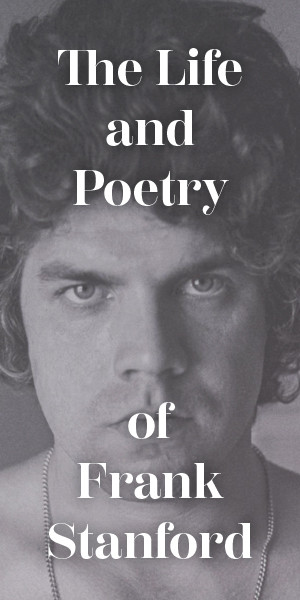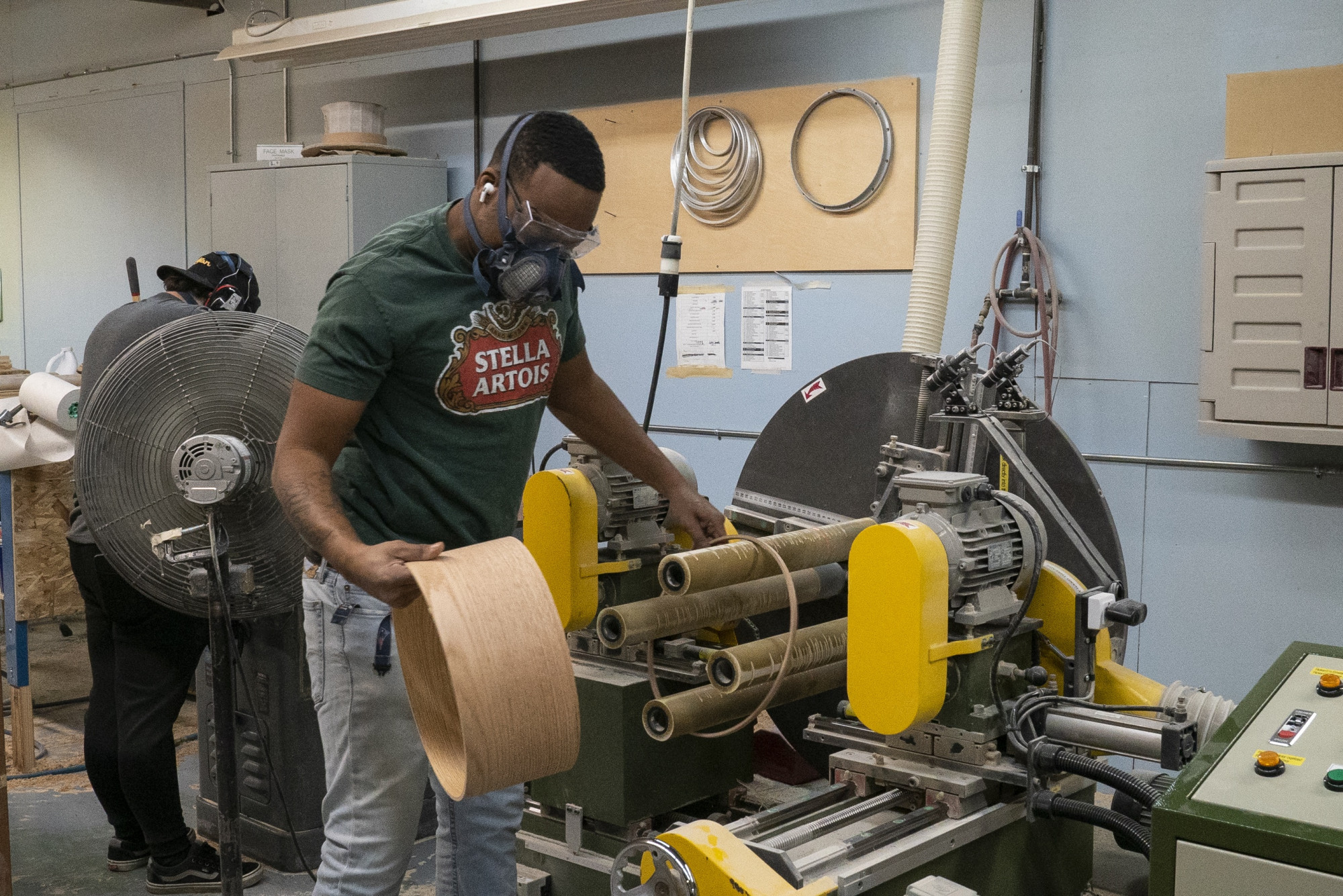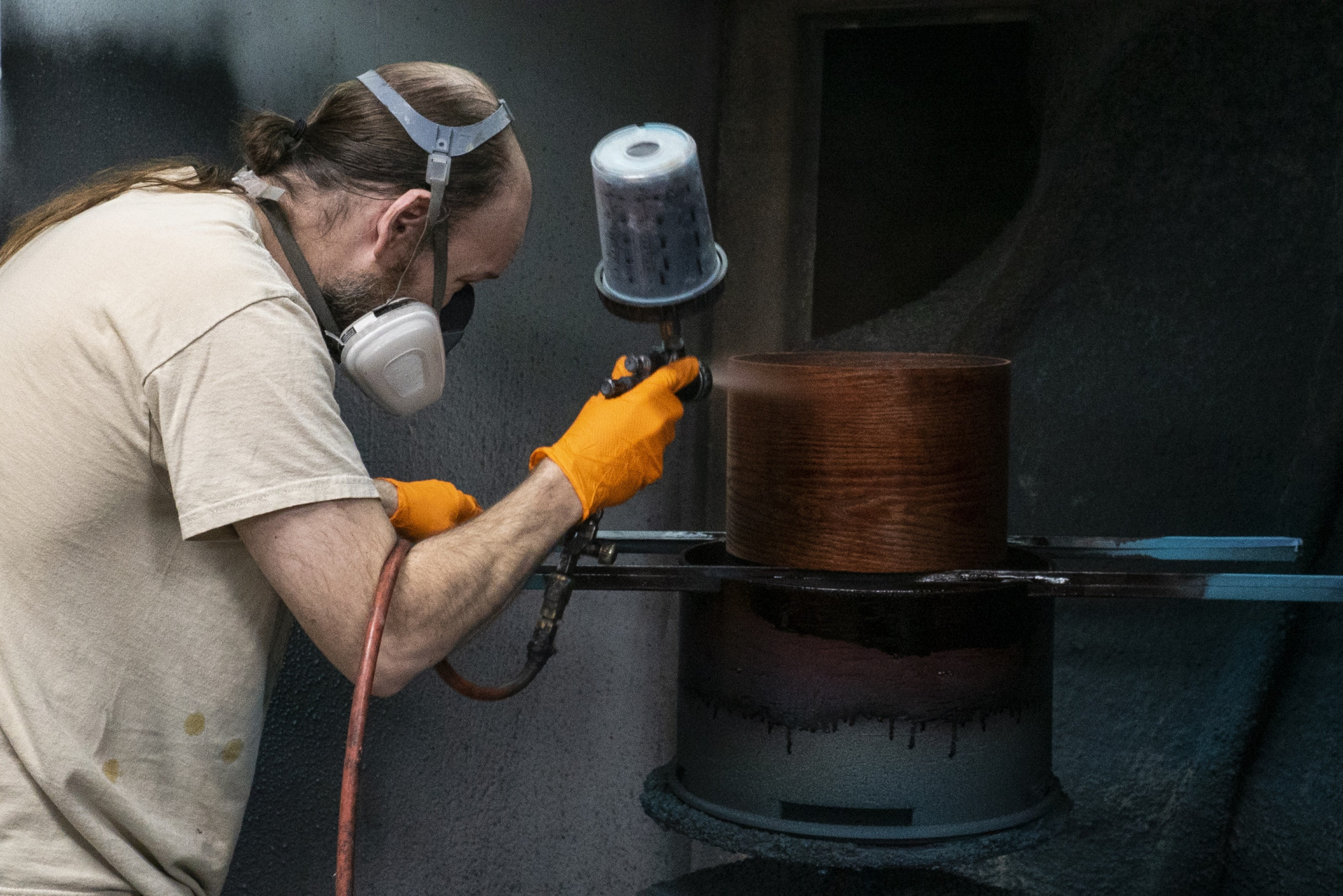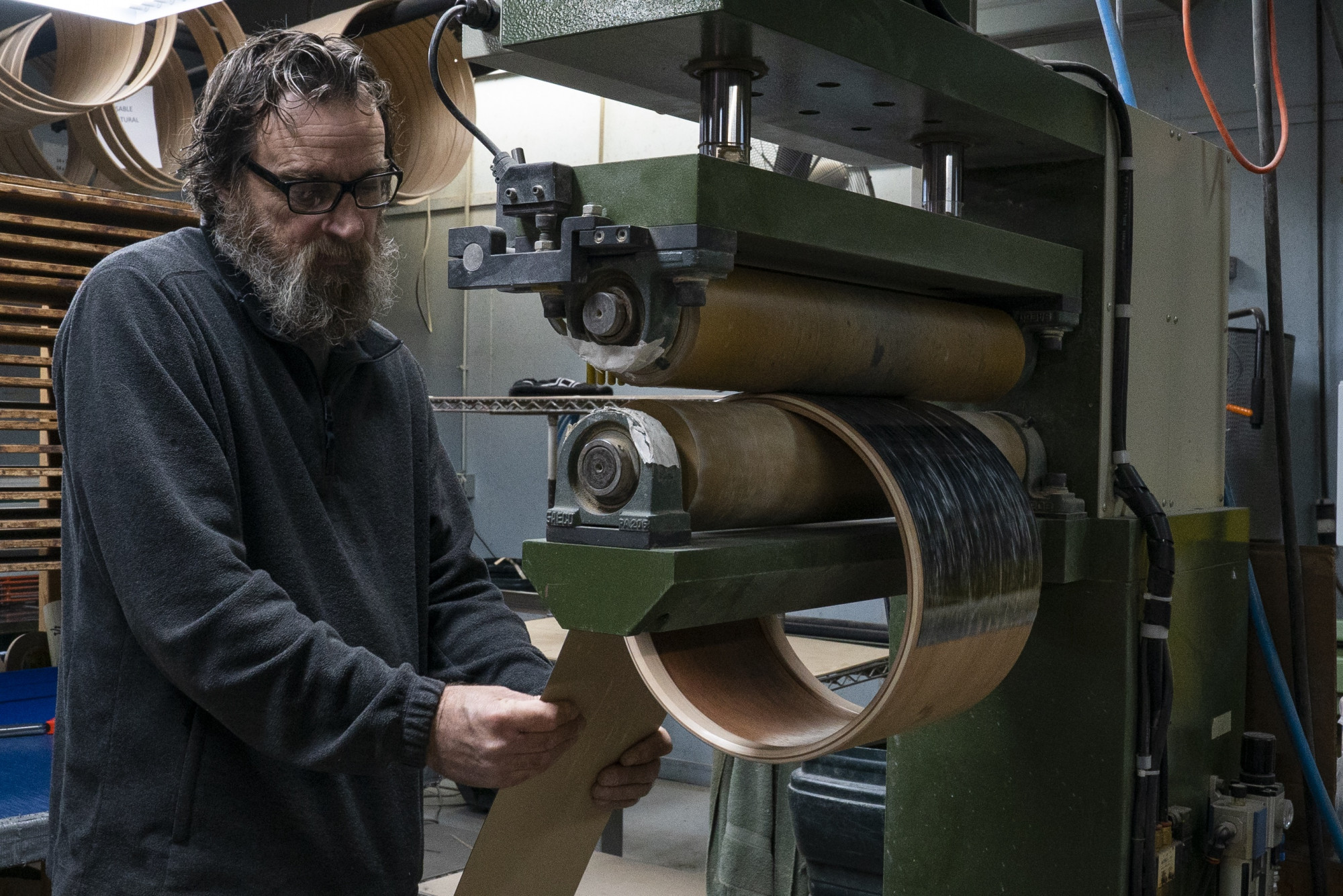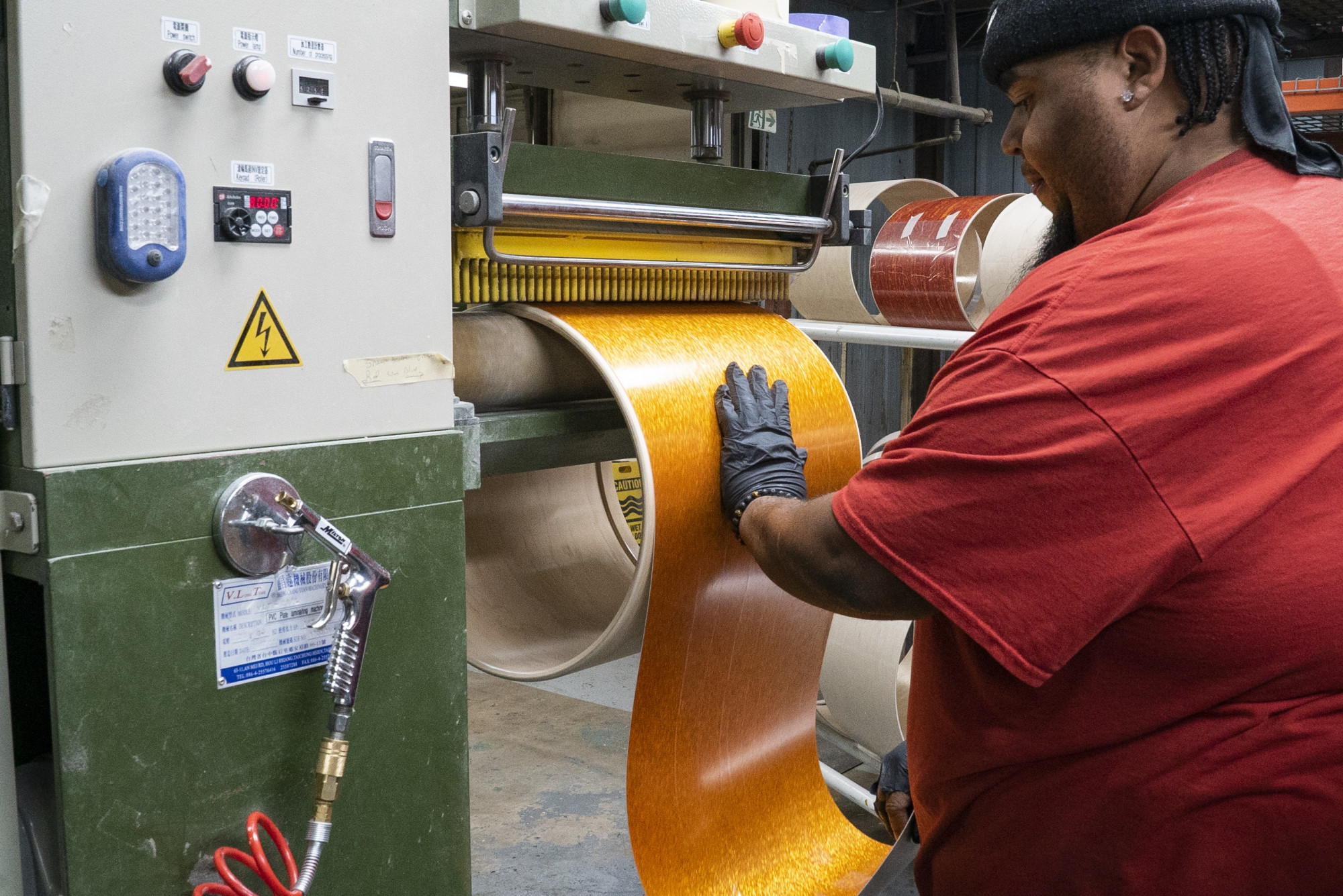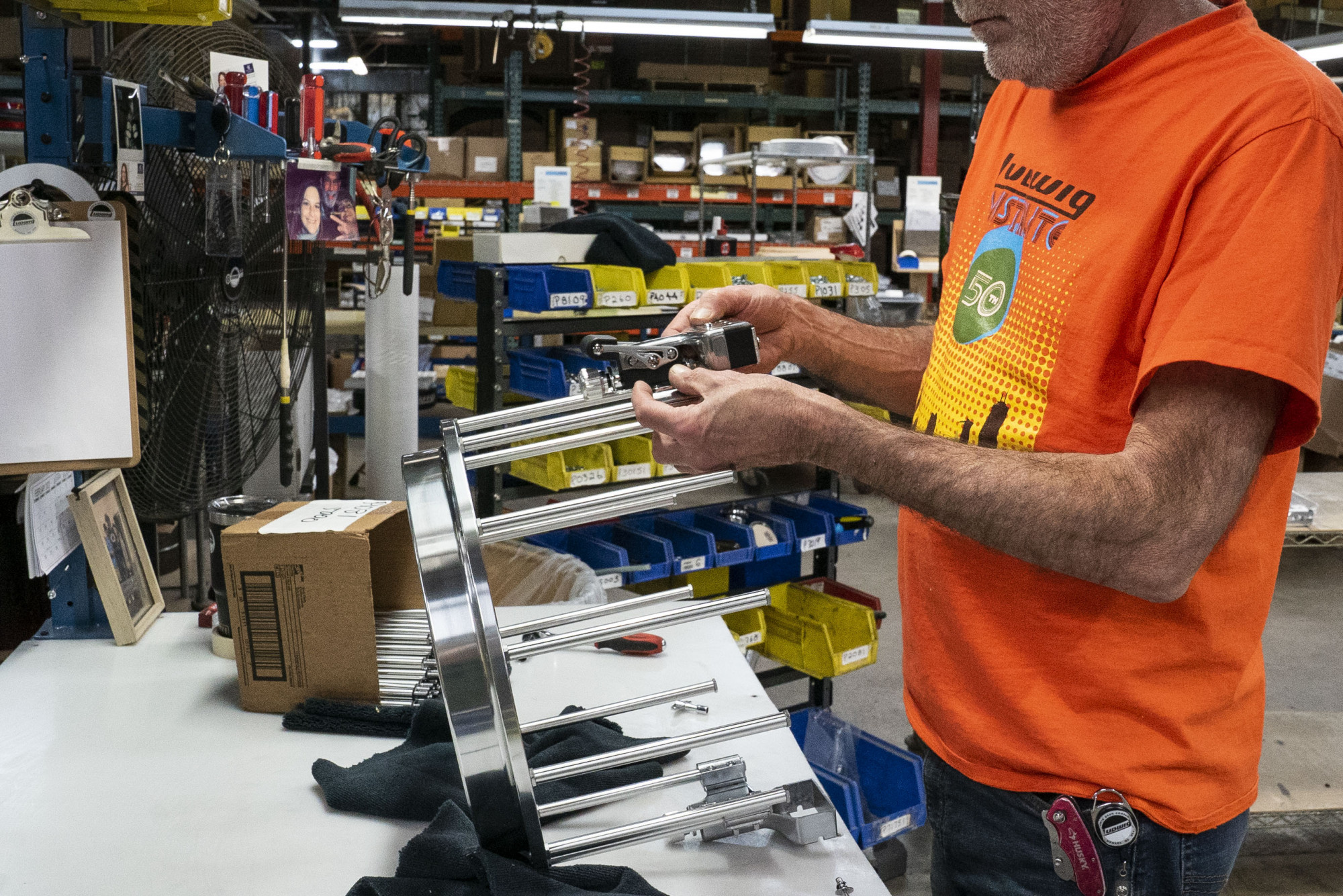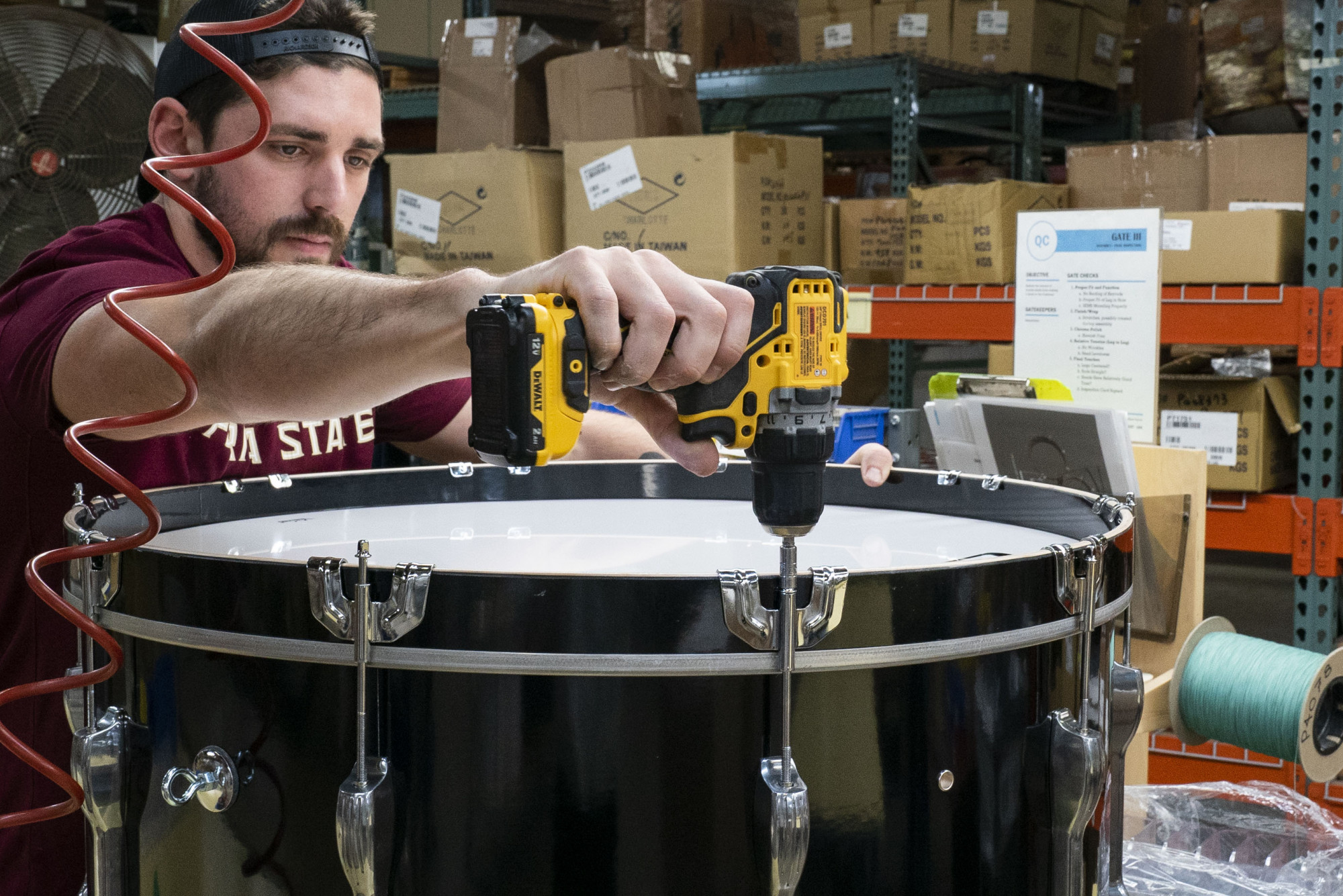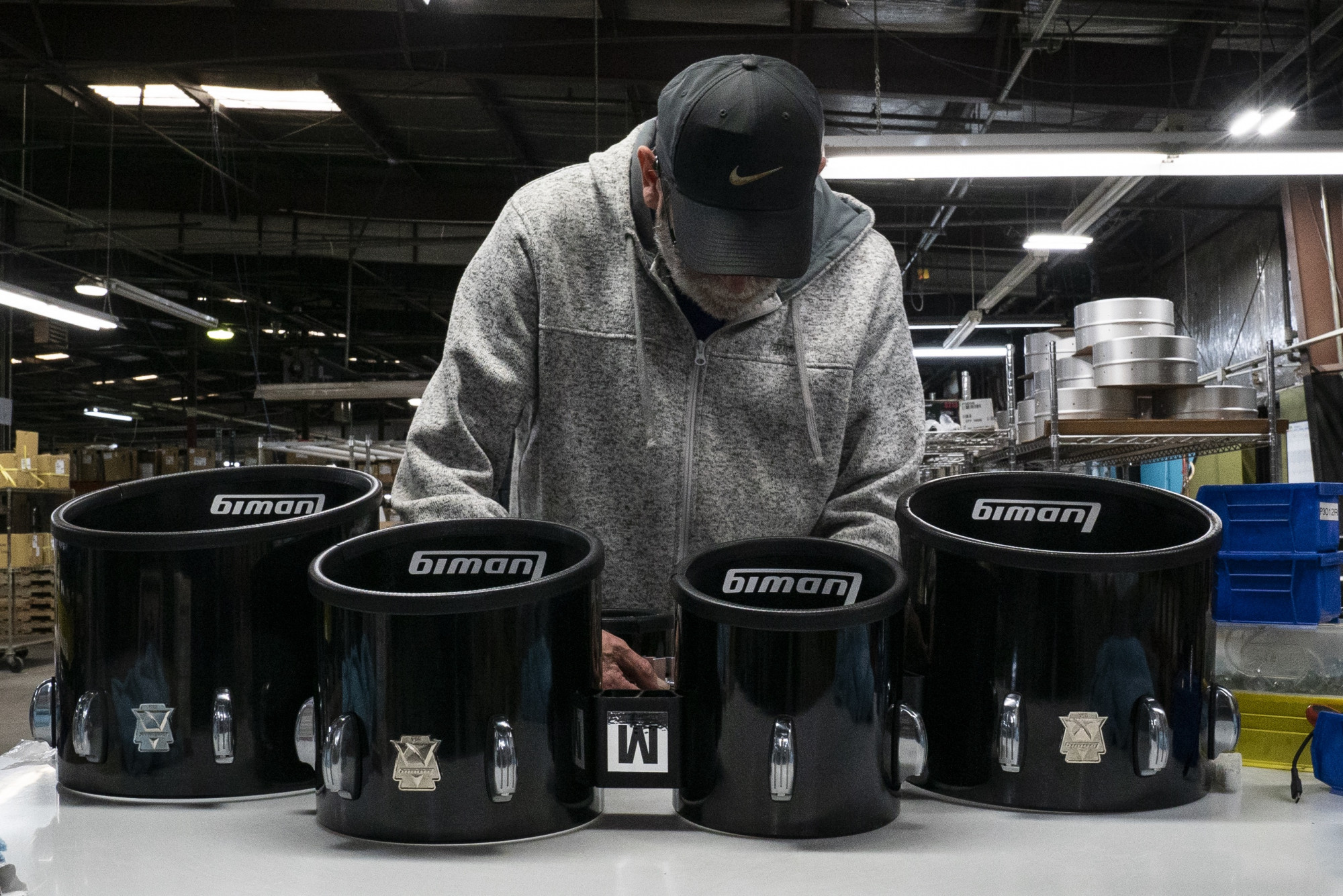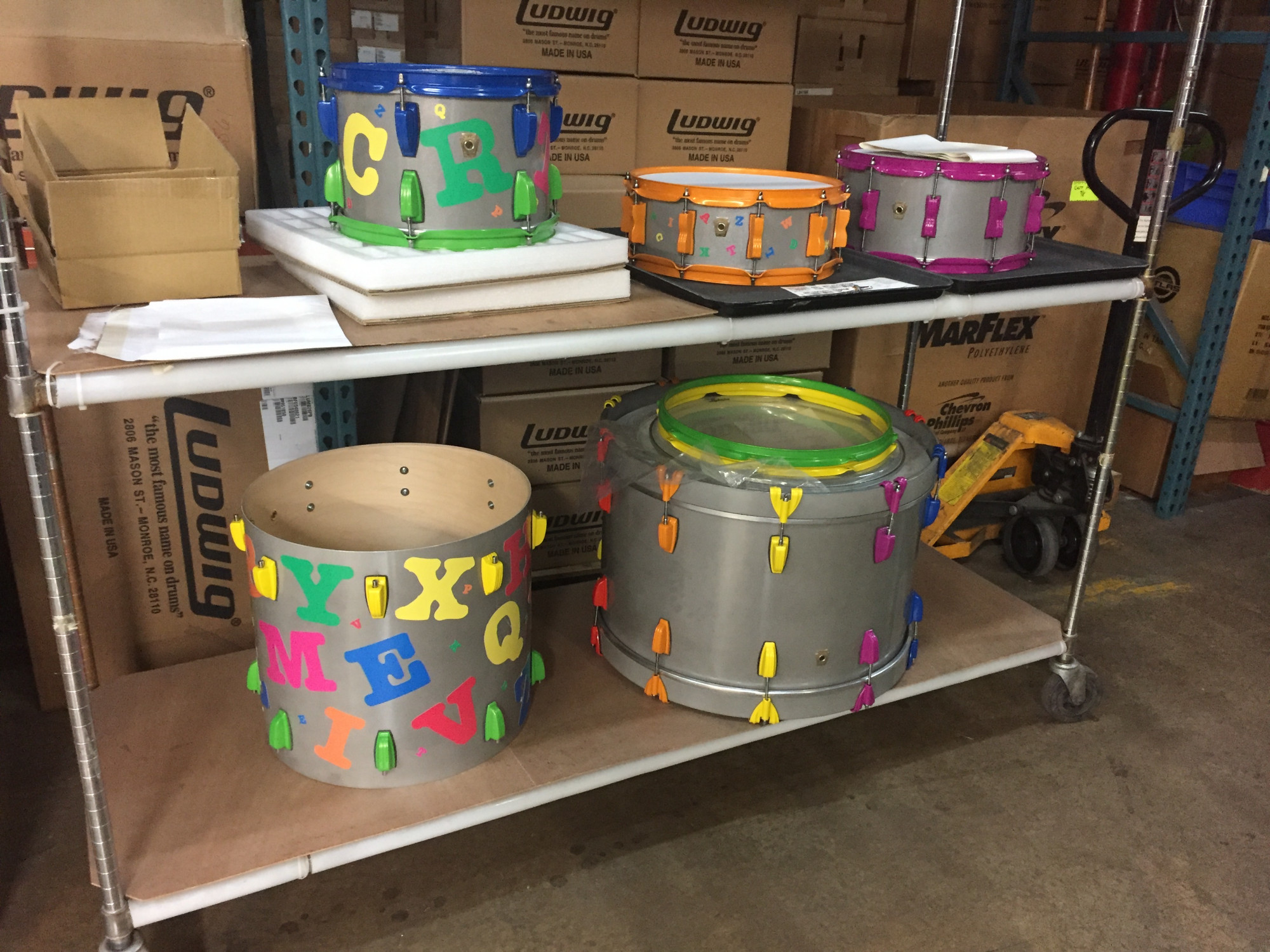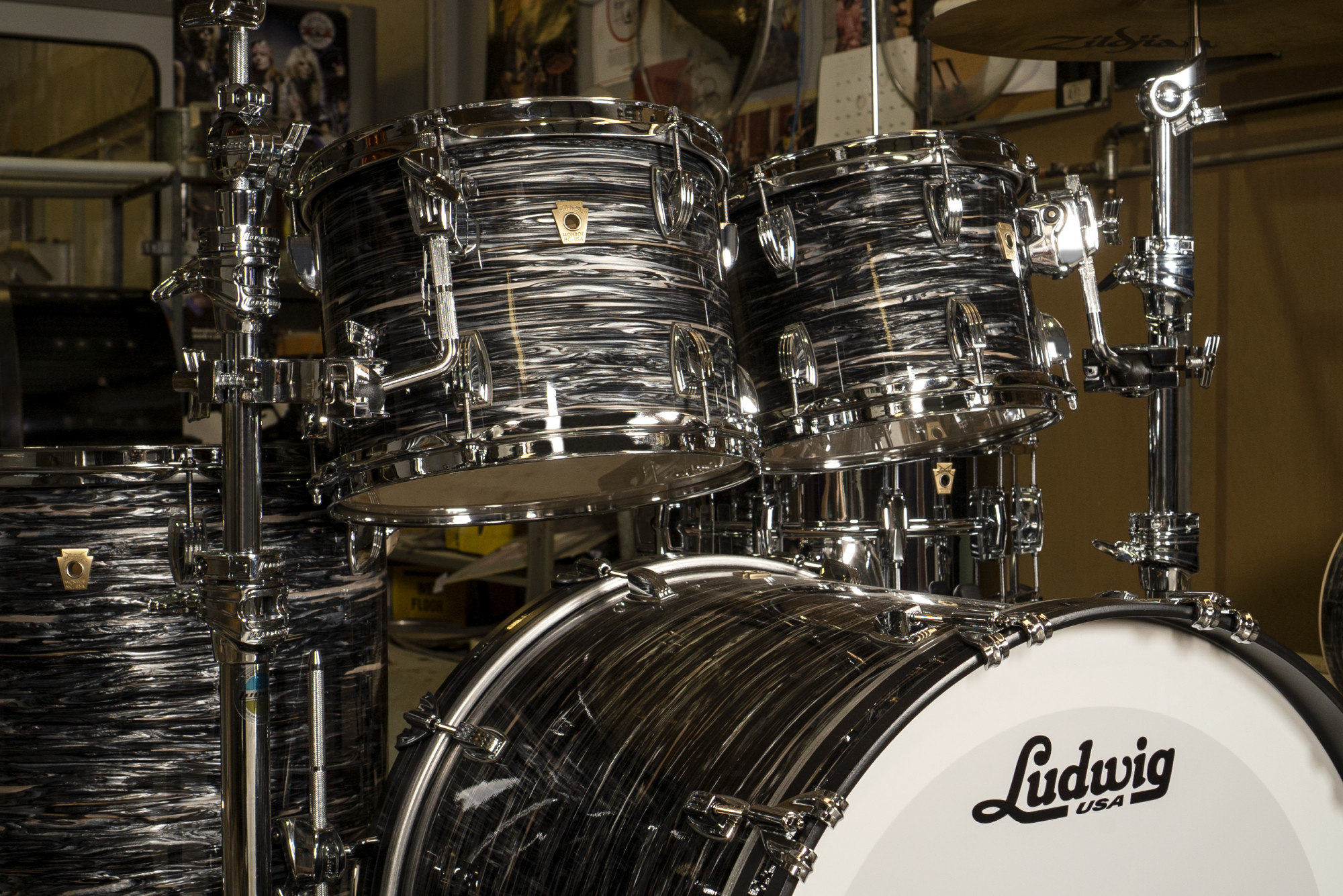
Photo courtesy of Ludwig Drums
Inside the Ludwig Drums Factory
Ringo Starr made Ludwig drum kits popular, but the instrument makers of Monroe, North Carolina, keep them that way
By Andrea Cooper
Ringo Starr was out in London with The Beatles’ manager, Brian Epstein, when he spotted a drum kit in an instrument shop window. Starr loved the kit’s black oyster pearl wrap. He tried out the sound and loved that, too. As he finished his purchase, the clerk leaned over to remove the Ludwig decal from the bass drum. “No, no, no!” Starr admonished. “You gotta leave that on. It’s American.”
Starr brought the drums with him for the Beatles’ 1964 debut on The Ed Sullivan Show. About seventy-three million viewers saw the Ludwig name as Starr bobbed his head and propelled “I Want To Hold Your Hand” into rock history.
Since 1984, Starr’s favorite drums have been created in a complex of four buildings not far from a chicken processing plant in Monroe, North Carolina, a town of about 38,000 outside Charlotte. The 150,000 square-foot factory produces professional and semi-pro kits, along with timpani and marching drums. Starr’s black oyster kit wrap “is still our number one selling color, sixty-something years later,” Uli Salazar, director of marketing and artist relations, said during a recent interview and factory tour.
Ludwig Drums is more than one hundred years old, endorsed by the likes of jazz great Buddy Rich and drummer John Bonham of Led Zeppelin. Top drummers who perform on Ludwig include Questlove, on The Tonight Show, and the drummers for Tyler Childers and Taylor Swift. Ludwig drums are sold worldwide and have been heard in recordings, concerts, movies, and the Grammys.
Many people are surprised to learn the iconic drums are made in the South. That included me, though I’m married to a musician and live half an hour from the plant. What brought Ludwig here, I wondered, and what made them stay?

The Beatles on stage at The Ed Sullivan Show, 1964, Photo by Bernard Gotfryd, Public domain, via Wikimedia Commons
Without a passing parade, we might be talking about Ludwig Violins and Pianos instead of Ludwig Drums. William F. Ludwig, son of German immigrants Heinrich and Johannette, arrived in Chicago in 1887 when William was eight years old. He began lessons on violin and piano, but everything changed the day that he happened upon a marching band in a parade. Captivated, the boy followed the drummers to the end. Soon he confessed to his father that he had been skipping his violin and piano lessons. “I’ll really study hard if you get me a drum,” he cajoled, according to an oral history account with his son, William F. Ludwig II. Heinrich caved and bought his son a drum for four dollars. William eventually became an accomplished drummer and toured with his father, a trombonist, in shows around the Midwest.
In 1909 William and his brother, Theobald, founded the Ludwig & Ludwig Drum Company. Vaudeville acts or small clubs often used multiple percussionists, each playing a single instrument. “People were tinkering at the time,” Salazar recalled. “How could we play multiple pieces as one? We got four limbs, so there’s got to be a way.”
With help from a brother-in-law skilled in engineering, the Ludwig brothers invented the first retractable spring bass drum pedal. It allowed the player to use his foot to strike the drum at a much quicker pace than previously possible, leaving the hands to cover the snare part. Now one or two people could sound like a bigger ensemble. The brothers’ connections to players around the Midwest and East Coast helped their invention take off.
The Ludwigs innovated in marketing, too. Drum companies sold packages with different percussion instruments, but no one was promoting a standardized set—a drum kit. Ludwig & Ludwig introduced the Jazz Er Up kit in 1918 with just a single snare, a bass drum, a woodblock and cymbals. To modern eyes it looks pretty modest, but soon competitors copied the concept. Theobald died that year during the influenza pandemic, but William kept refining his products.
In 1922 the company debuted a hand-engraved brass snare drum plated in a black nickel finish, a predecessor to the model known as Black Beauty still produced today. (Drummer Art Cruz of heavy metal band Lamb of God is among its fans and endorsers. He tells the story in a YouTube video of how he spotted the instrument at a drum festival in a different finish and didn’t recognize it initially. “I hit it and was like, ‘That’s a fucking Black Beauty.’” He pounded it on his group’s next tour.)
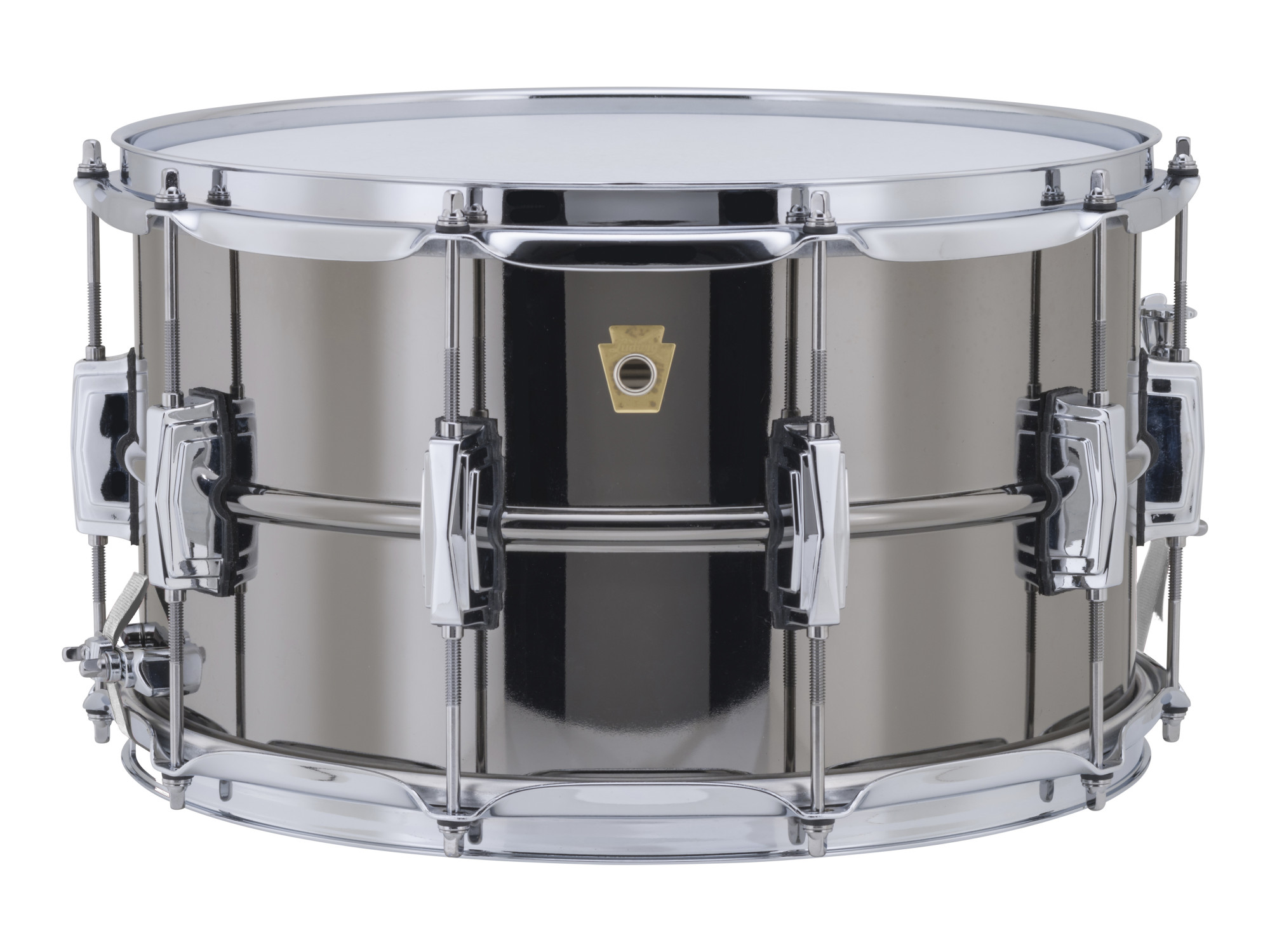
Ludwig’s Black Beauty snare, Photo courtesy of Ludwig Drums
Market conditions leading to the Great Depression forced William to sell the company to C.G. Conn in Elkhart, Indiana, in 1930. Though William stayed with the company, over time, he felt he was losing control of the brand. “There was a lot of head-butting and disagreements going on behind the scenes. So he decided to start all over,” Salazar said.
William left Ludwig under C.G. Conn in 1937 to establish his own independent drum business, WFL Drum Company, in Chicago with his son William II. William Sr. likely had saved enough from the sale to Conn and his subsequent employment with them to believe the new venture was viable. “But it was very touch-and-go,” Salazar said. “All they had was four walls and ambition.” Some would argue the timing could have been better. While recovering from the Depression, the U.S. economy sank again and experienced one of the worst recessions of the twentieth century between May 1937 and June 1938 .
Between the aftermath of the Depression and World War II, the business might have failed. Instead, it won a contract during the war to supply drums for military bands on American bases. “I don’t think we would have gotten our second wind without that government bid for that drum,” Salazar said. “Between that and The Beatles, I think that really kind of sealed our fate.”
William managed to buy back the Ludwig name in 1955 to re-form the Ludwig Drum Company. His son recalled how the company flourished post-Ed Sullivan. “Immediately, everybody wanted a Ringo set in this country,” William II said in an oral history account with NAMM, a music industry trade association. “We had to add a second shift. For three and a half years, we ran flat out nothing but Beatle sets.”
Fans included Bun E. Carlos, the original drummer for the rock band Cheap Trick and a Ludwig endorser. He got his first Ludwig kit back in high school, in 1966. Ludwig Drums “sound like all my sixties drum heroes, like Ringo and Ginger Baker and Mitch Mitchell,” he said in an interview.
William II became president of the company following his father’s death in 1973. He retired and sold Ludwig Drums to the Selmer Company in 1981. The leadership grappled with concerns about the quality of craftspeople in the Chicago area and their lack of woodworking expertise. Labor costs were rising as offshore competitors pushed Ludwig on price. Production costs would be lower in a smaller town.
Ludwig officials considered El Paso, Texas. But North Carolina had its attractions. For decades, the state had been known as a center for furniture manufacturing, leading to plenty of woodworkers in the labor force. Ludwig already had a connection in Monroe. Selmer manufactured band instrument cases there, many made of wood. Sourcing and shipping wood was cost-effective thanks to mills in the region, which were close to seaports to import hardware. The North Carolina climate helped, too: milder winters were better for storing wood. While the area’s furniture industry still thrived at this time, Ludwig could appeal to skilled furniture workers looking for somewhere new to use their talents.
Ludwig was up and running in Monroe by its seventy-fifth anniversary, in 1984. Following a merger, its parent company today is Conn Selmer—the same Conn that had purchased Ludwig back in 1930.
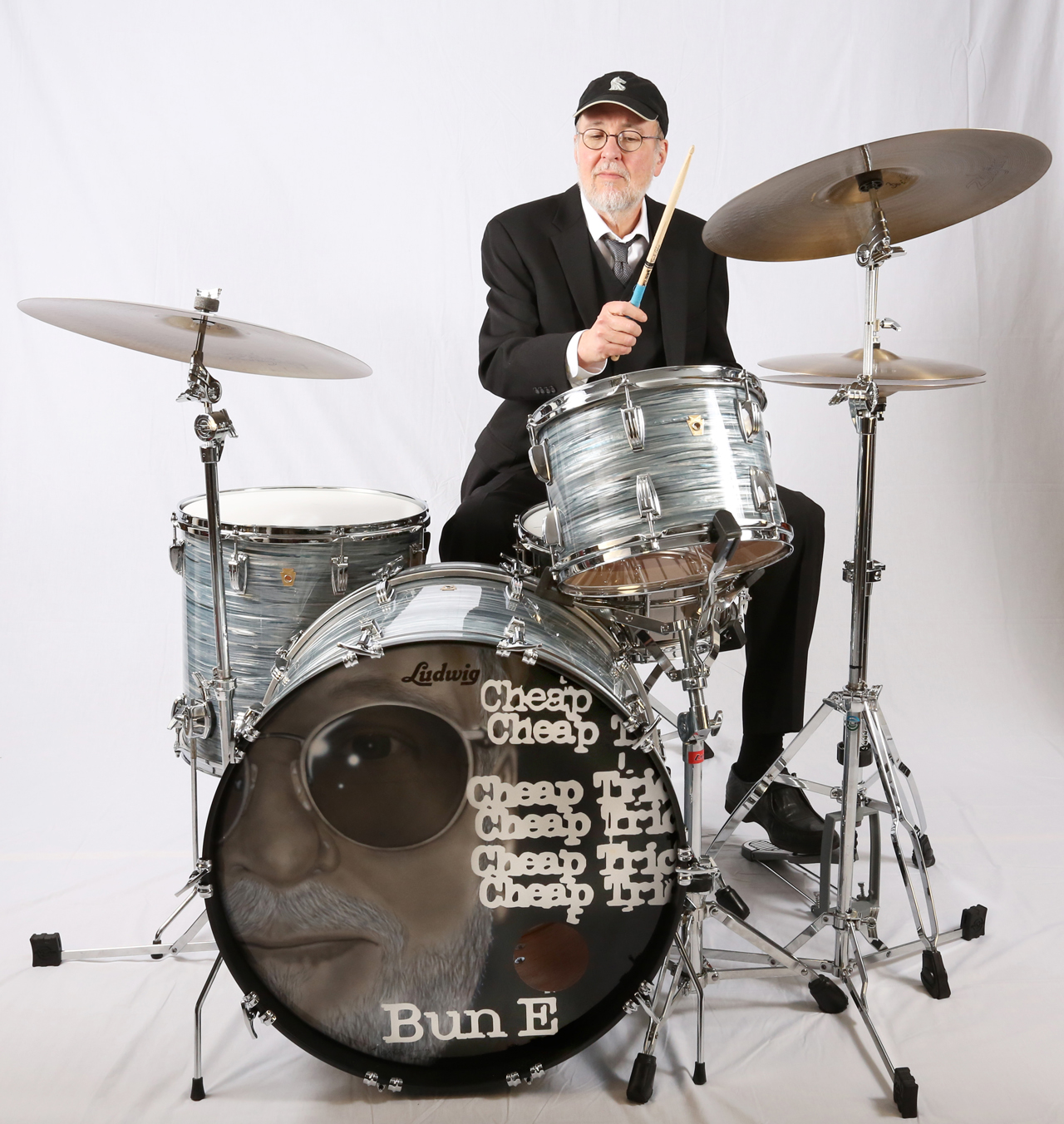
Bun E. Carlos, drummer for Cheap Trick, Photo courtesy of Ludwig Drums
The Ludwig factory is its own kind of percussive ensemble. It thrums and whines, whooshes and buzzes, each computerized machine contributing to the whole. Fifty-five employees work here, including Don Taylor, a fourteen-year veteran. Each month, they produce shells for more than three hundred kits and seven hundred snare drums, along with forty to sixty kettles for timpani. On our tour, Salazar and I watched as Taylor cut wood using a laser-guided saw for greater precision. Taylor gained his knowledge of how to handle wood through his previous employment in the furniture industry.
Later, Taylor showed us a find from a thrift store: one of the military drums that Ludwig made during the Second World War, still in fine condition. When I admired it and asked Taylor what he enjoys about making drums, he gave an answer that others in the plant, some of them drummers, might echo. “It’s just to know they’re out there. It’s amazing to me that I’m making something for Ringo or Questlove or big-name people. It’s got my hands on it.”
About seventy percent of Ludwig’s products are constructed with wood, which arrives at the factory in flat laminated sheets. The first step is to raise its moisture content so it can be bent and molded. Different species of wood, different thicknesses and even different diameters all influence the sound. Classic maple, Ludwig’s most popular wood, “tends to have a nice, even balance of lows, mids, and highs,” Salazar explained. Maple is bright compared to mahogany, which has a mid-range, “woody” sound because it’s so porous. Oak is darker and louder.
Ludwig offers several series that blend woods; think cherry and maple, or mahogany and poplar. The shells are bound using proprietary adhesives that have more elasticity to help create the Ludwig sound. “It just responds with a little bit more freedom,” Salazar said. Another key element is the contoured top and bottom edges of the drum shell where it joins the drum head, known as the bearing-edge cut. Cut the edge properly and the drum will sing. Leave it flat, Salazar said, and the drum is “going to be dead.”
Once the drum is shaped, it’s prepared for one of several finishes, including paint and lacquer. Wraps offer opportunities for flair. Some are made from acetate and PVC film mixed and manufactured in Italy, then sent to a U.S. company for lamination, and finally shipped to Ludwig for application. Over the last few years, Ludwig has been able to recreate colors from the 1960s such as Vintage Pink Oyster or Citrus Mod. It’s a feat considering that no one in Italy documented exact proportions for the mixtures sixty years ago, and some used lead-based dyes that are now banned. Bun E. Carlos told me that his drum collection has included a Ludwig drum of “about every finish they ever put out from the 1920s to up to date.” When the company has considered reissuing finishes from the past, they’ve sometimes paid a visit to Carlos to see the original.
The best-known drummers get custom creations that they help design. Salazar brainstorms with them about the sound and look of their kit. Some drummers love the fashion of drums and the process of coming up with new looks. Questlove once requested a working drum set made of Legos. It didn’t happen, partly due to time constraints, but Ludwig developed a kit for him featuring letters on the drums similar to a child’s alphabet blocks, plus a thermochromic paint that changes colors depending on the temperature. Carlos partnered with Ludwig to create a limited edition snare drum for sale to celebrate the band’s fiftieth anniversary. Its colorful shell is decorated with unused Cheap Trick tickets that Carlos saved while touring over the years.
The factory builds more than drums. In the Musser brand section, employees build mallet percussion instruments such as xylophones, glockenspiels, and marimbas. This is exacting work of a different sort. A glockenspiel has to be in tune when it leaves the factory because there’s no way to tune it afterwards. For quality control, the factory has separate rooms for precise tuning of tubular bells or vibraphone bars.
Many old-timers at the plant have retired. Towards the end of the tour, we stopped by the office of one of the younger leaders. Ryan Taylor (no relation to Don) is an engineering supervisor who majored in mechanical engineering and minored in drum set performance at Old Dominion. He interned at Ludwig and was thrilled to get a job there about ten years ago. “There’s really only a few USA drum manufacturers who actually hire engineers,” he said.
Ludwig is experiencing a high after some leaner years. “The drum business itself hasn’t grown in meaningful ways, but we’ve taken a lot more market share,” Salazar explained. “We certainly sit in the top three of most in-demand professional drum brands, where that wasn’t the case ten years ago.” He credits fresh interest in the “classic Ludwig sound” from contemporary players, product innovation, and partnering with artists “who carry the biggest influence with the next generation of players.”
We’re at the end of the tour when Salazar shows me a few instruments on display from Ludwig’s storied past: Butch Miles’s drums, blazoned with BASIE, from the Count Basie Orchestra. Karen Carpenter’s original snare drum. Cheap Trick’s kit from their induction performance at the Rock and Roll Hall of Fame. A kit retrofitted with a 1970s vibe for the “Joker” movie.
It’s late in the afternoon when I take my leave and shoot a few photos of the plant exterior, mostly to remind myself that, save for the signs, few people walking past would guess something extraordinary is happening inside. As Ryan Taylor put it earlier, Ludwig is “a very emotional place for me to work because the impact is not what I get paid on the weekend.” The music and the artists’ excitement is the driving force. Take Carter McLean, drummer for The Lion King on Broadway for years. Cut open his drums and you’d see, per his request, the signatures of every Ludwig employee who helped make them.

Photo courtesy of Ludwig Drums
Editor’s note: Ludwig doesn’t offer regular public tours of the factory, but email [email protected] and they can arrange one.



